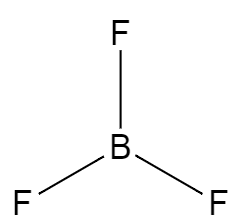Question
Question: Explain the formation of \(B{{F}_{3}}\) molecule using hybridisation...
Explain the formation of BF3 molecule using hybridisation
Solution
The hybridisation of any compound uses the valence bond theory according to which the hybridisation or the mixing of the orbitals takes place and all the hybrid orbitals have equal energy.
It takes in account the electronic configuration of the central atom in the compound and the unpaired electrons in the central atom vouches for the incoming electrons from the other atoms.
Complete step-by-step answer:
The electronic configuration of boron is 2s22p1, so we can see that it has one unpaired electron. So, this electron from the ‘s’ orbital gets excited to the higher energy level and forms 2s12p2 where all the electrons are unpaired.
The structure of boron trifluoride consists of an atom of boron along with the three fluorine atoms which are in 120∘ angle with one another. So, the geometry of this structure is trigonal planar. The structure can be represented as,

The boron has only three electrons in its outermost orbital and the fluorine atoms have seven electrons in its outermost shell. So, during the formation of the compound the 2s orbital and the two 2p orbitals combine with each other and form a hybridised orbital which is sp2.
Hence the boron trifluoride molecule is formed and with the use of hybridisation, which is the required answer.
Note: The formation of the boron trifluoride takes place when one ‘s’ orbital and two ‘p’ orbitals in order to become three sp2 orbitals which have equal energy.
This process is based on the valence bond theory and it takes in account the orbitals of individual atoms.
